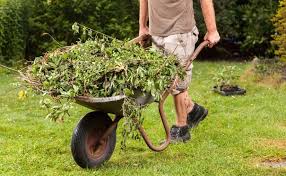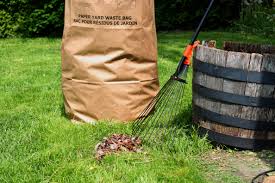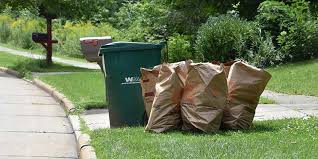Yard waste refers to the natural materials that come from your yard or garden, like grass clippings, leaves, branches, and other plant debris. Basically, it’s the stuff from your outdoor space that you want to get rid of, such as when you clean up your garden or mow your lawn.
Maintaining a beautiful yard or garden is a source of joy for many people. However, as the seasons change and plants grow, yard waste can pile up. What exactly is yard waste, and how can you manage it in an eco-friendly way?
Yard waste is all the natural stuff that comes from your outdoor space. Think of it as nature’s leftovers. This includes things like:
1. Grass Clippings: When you mow your lawn, those little bits of grass that get cut are yard waste.
2. Leaves: In the fall, trees shed their leaves, and they become part of your yard waste.
3. Branches and Twigs: When branches break off or you trim your bushes, these pieces are yard waste too.
4. Weeds: Pulling weeds from your garden adds to the yard waste pile.
5. Garden Plants: When your veggies or flowers have seen better days, they become part of the mix.
Now that we know what it is, what can we do with yard waste that’s good for the environment?
1. Composting: One of the best things you can do with yard waste is composting. This is like recycling for nature’s leftovers. You mix your yard waste with kitchen scraps, and over time, it turns into nutrient-rich soil that can help your garden grow.
3. Mulching: Shredded leaves or small branches can be used as mulch in your garden. Mulch keeps the soil moist, prevents weeds, and helps your plants thrive.
4. Curbside Pickup: Many places have curbside pickup for yard waste. They collect it and turn it into compost or mulch for community use.
5. Local Regulations: Check your local regulations. Some areas have rules about how to dispose of yard waste. They might have designated drop-off sites or specific bags you need to use.
6. Avoid Burning: Burning yard waste can release harmful pollutants into the air, so it’s better to find alternative ways to deal with it.
Remember, yard waste is a valuable resource for your garden and the environment. By managing it wisely, you can keep your outdoor space beautiful while being kind to nature at the same time.
Read Also: A Guide Construction and Demolition and Debris
Yard Waste Collection

Yard waste collection is a vital service that helps keep our neighborhoods clean, green, and vibrant. But what exactly is it, and why is it important? Let’s dive into the world of yard waste collection in simple terms.
What is Yard Waste Collection?
Yard waste collection is the process of gathering up all the natural materials that come from our yards and gardens, such as leaves, grass clippings, branches, and other plant debris. It’s like giving our outdoor spaces a tidy makeover.
Why is Yard Waste Collection Important?
1. Cleanliness: Yard waste can pile up quickly, especially during seasons when trees shed leaves or when we trim our hedges. Collection services ensure our streets and yards stay neat and tidy.
2. Health and Safety: Rotting yard waste can attract pests and insects, potentially causing health problems. Prompt collection keeps these issues at bay.
3. Environmental Benefits: Yard waste can be recycled and turned into valuable compost or mulch, benefiting our gardens and reducing the need for chemical fertilizers.
How Does Yard Waste Collection Work?
4. Containerization: Yard waste is typically placed in special bags, bins, or bundled neatly for collection. These containers are designed to hold the waste securely and prevent it from blowing away.
5. Scheduled Pickups: Most communities have scheduled yard waste pickups, usually on specific days of the week or month. Residents place their prepared yard waste containers by the curb, and collection crews come to pick them up.
6. Composting and Recycling: After collection, yard waste often undergoes composting or recycling processes. This transforms it into nutrient-rich compost or mulch that can be used to enrich soil and support plant growth.
Tips for Effective Yard Waste Collection
1. Follow local guidelines: Different areas may have specific rules regarding how to prepare and present yard waste for collection. It’s essential to follow these guidelines to ensure efficient pickup.
2. Avoid mixing with other trash: Keep yard waste separate from regular household trash to facilitate recycling and composting.
3. Bag or bundle properly: Use designated yard waste bags or containers and securely bundle branches to make collection easier.
4. Be mindful of collection schedules: Know when yard waste pickups occur in your neighborhood and plan accordingly to avoid missed collections.
Yard waste collection plays a crucial role in maintaining the beauty and cleanliness of our communities. It not only keeps our neighborhoods looking pristine but also contributes to a greener and more sustainable environment by recycling yard waste into valuable resources for our gardens and landscapes.
Read Also: Exploring the Benefits of Plastic Waste
Yard Waste Guidelines

When it comes to managing yard waste, following some simple guidelines can make a big difference in keeping your outdoor space clean and environmentally friendly. Here is a breakdown of yard waste guidelines in easy-to-understand terms:
1. Know What Counts as Yard Waste: Yard waste includes natural materials from your yard or garden, like leaves, grass clippings, branches, and plant debris. Basically, it’s the stuff that comes from your outdoor space.
2. Separate Yard Waste from Regular Trash: It is important to keep yard waste separate from your regular household trash. Mixing them can make it difficult to recycle and compost the yard waste.
3. Use Proper Containers: To make yard waste collection efficient, use the right containers. Many places provide special yard waste bags or bins. If not, you can use paper bags or reusable containers designed for yard waste.
4. Bag or Bundle Neatly: When placing yard waste at the curb for collection, bag leaves and grass clippings. For branches and twigs, bundle them securely with twine. Neatly bundled or bagged yard waste is easier for collection crews to manage.
5. Avoid Plastic Bags: Never use plastic bags for yard waste. They don’t break down like paper bags and can harm the environment.
6. Follow Local Guidelines: Different areas have different rules for yard waste collection. Be sure to follow your local guidelines, which might include specific pickup schedules or regulations on what can and cannot be collected.
7. Keep It Clean: Remove any foreign objects or non-organic materials from your yard waste. This includes things like plastic, metal, or rocks. Clean yard waste is easier to recycle.
8. Don’t Overfill Containers: Avoid overloading your yard waste containers. If the container is too heavy or overflowing, it may not get collected.
9. Compost When Possible: If you have the means, consider composting your yard waste. Grass clippings, leaves, and even small branches can be turned into nutrient-rich compost for your garden.
10. Support Local Recycling Efforts: Yard waste collected by your community is often recycled into compost or mulch. By participating in yard waste collection, you’re supporting eco-friendly recycling initiatives.
By following these yard waste guidelines, you’re not only helping to keep your outdoor space clean and tidy but also contributing to a greener and more sustainable environment. It’s a small effort that can make a big impact on the health of your community and the planet.
Read Also: Sales Promotion Objectives and Methods

